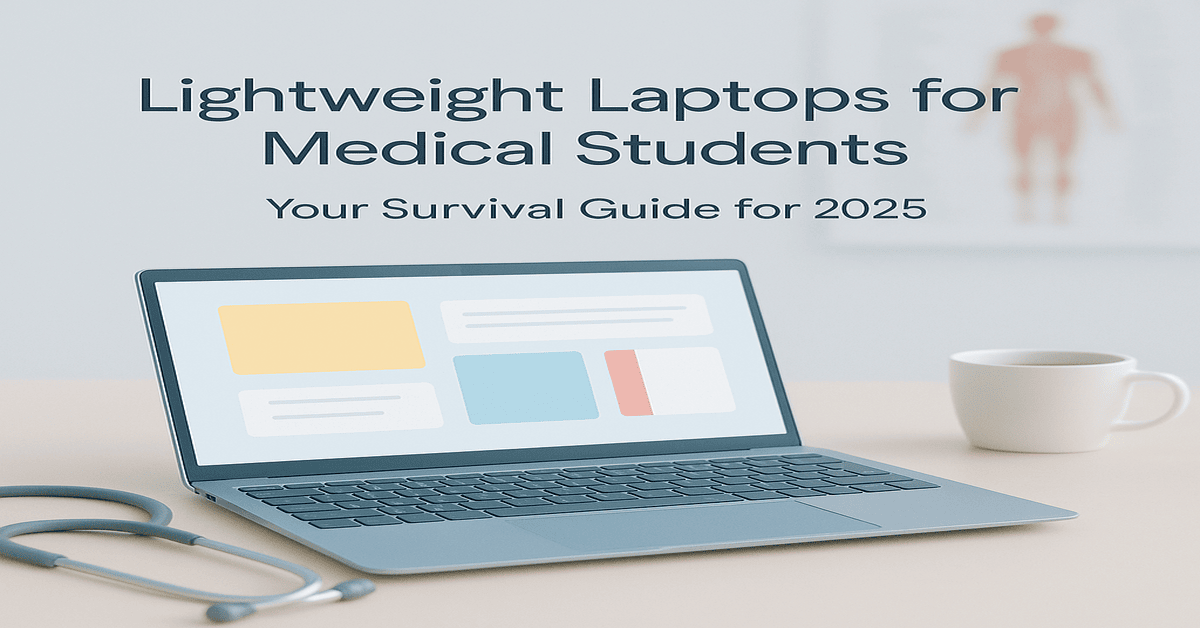School is tough enough without carrying a huge laptop around! Pick one that feels nice and light when you use it for notes or on the go. When your bag isn’t heavy, it’s easier to feel good all day long—and you’ll have more energy too! This quick list will help you find just what works best for students who move fast.
Why Lightweight Laptops Matter for Medical Students
School days are busy and tough. Heavy things slow you down, like thick books or big computers.A small, light laptop is best. It fits anywhere—a desk, your bag, even on your lap during short breaks at school or work.Carry less weight every day so your body feels good now and later! A simple choice can make classes easier right away.
Key Requirements for Medical School Laptops
Essential Features to Consider
Light and Easy to Carry
Pick a laptop that is light. If it weighs more than 3 pounds, it’s too much. The best ones weigh around 2.6 pounds. They are easy to carry and won’t hurt your back.
Long Battery Life
You need a laptop that lasts all day. Some work for only 5 hours. That’s not enough. Others, like the LG Gram, can last 22 hours. You can work all day without plugging it in.
Bright and Clear Screen
You will look at notes and pictures a lot. A clear screen helps your eyes. OLED screens show bright colors. The Acer Swift 3 has a screen that shows every little thing.
Fast and Smooth
You will use many apps and tabs. Slow laptops waste time. Laptops with Intel i7 or Apple M4 chips are fast. They work well for school and fun.
Lots of Space
You will save notes, videos, and papers. You need space for all of it. A 512GB drive is okay. But 1TB is even better. You can also keep fun stuff like cat videos
Top Lightweight Laptops for Medical Students in 2025
Apple MacBook Air (M4)
The MacBook Air is super light. It weighs only 2.7 pounds. The webcam is better for video calls. You can use more than one screen. It now costs $999. You might only need to sell plasma twice to buy it!
LG Gram 16
This laptop has a big 16-inch screen. But it weighs less than 3 pounds. The battery can last up to 22 hours. It runs fast and has lots of space. It’s perfect for doing many things at once.
Asus ZenBook Duo
This laptop has two screens. The main one is 14 inches. The second one is 12.6 inches. It helps you see your notes and books at the same time. It weighs just 2.6 pounds. The battery lasts about 5 hours, so stay near a plug.
Microsoft Surface Pro Series
The Surface Pro 9 works as a laptop and tablet. You can type, draw, or tap on it. The Surface Laptop 7 has a strong battery. It lasts a long time, even on busy days.
Acer Swift 3 OLED
This laptop is great if you want to save money. The screen is bright and clear. It weighs 3 pounds and lasts 14 hours. The keyboard is a little soft. But it still works fine.
HP Pavilion X360 2-in-1
This laptop turns into a tablet fast. It’s good for drawing and reading. The hinge is strong. The keyboard is quiet. It’s great for busy school days.
Detailed Reviews and Comparisons
In-Depth Review: Apple MacBook Air Series
The M4 MacBook Air represents Apple’s latest iteration of medical student favorite. Beyond its lightweight design and powerful M4 chip, it’s now $100 cheaper than previous models—though at $999, it still costs roughly the same as one medical textbook. The new ice blue color option lets you coordinate with your scrubs, and its performance-to-weight ratio makes it the envy of study groups everywhere
In-Depth Review: LG Gram 16
Despite having a screen large enough to display an entire anatomical atlas, the LG Gram 16 manages to weigh less than some of your medical journals. Its 22-hour battery life means you can study through the night, catch a quick nap, and continue studying without ever touching a charger. The WQXGA display offers enough resolution to count individual cell nuclei, all powered by an Intel i7 processor that handles medical software better than some attendings.
In-Depth Review: Asus ZenBook Series
The ZenBook Duo’s dual-screen setup is revolutionary for medical students who need to reference multiple sources simultaneously. The main 14-inch touchscreen pairs with a 12.6-inch ScreenPad Plus that sits above the keyboard, giving you enough digital real estate to have anatomy diagrams, notes, and research papers all visible at once. The ErgoLift design tilts the keyboard for comfortable typing during those marathon study sessions, though you’ll need to keep the charger handy since battery life tops out at about 5 hours.
Comparison Table: Key Specs at a Glance
| Model | Weight | Battery Life | Processor | Display | Storage | Notable Feature |
| MacBook Air M4 | 2.7 lbs | Long-lasting | M4 chip | Excellent quality | 256GB+ | Center Stage webcam |
| LG Gram 16 | <3 lbs | 22 hours | Intel i7 | 16″ WQXGA | 512GB SSD | Ultra-lightweight |
| ZenBook Duo | 2.6 lbs | 5 hours | Intel i7 | Dual displays | 512GB SSD | Secondary touchscreen |
| Acer Swift 3 OLED | 3 lbs | 14 hours | Intel i5/i7 | 2880×1800 OLED | Unspecified | Budget-friendly |
| HP Pavilion X360 | Lightweight | Unspecified | Unspecified | Unspecified | Unspecified | Versatile 2-in-1 |
Choosing the Right Laptop: Use Cases
For Note-Taking and Lectures
For those who prefer digital notes over illegible handwriting, the Surface Pro 9 and HP Pavilion X360 excel with their touchscreen capabilities and stylus support. Nothing says “I’m detail-oriented” like perfectly organized digital notes—even if your actual locker looks like a medical supply closet after an earthquake.
For Clinical Rotations and Portability
When you’re racing between wards faster than caffeinated interns, the LG Gram 16 and ASUS ZenBook Pro shine. At under 3 pounds each, they’re light enough to carry all day without requiring a chiropractor appointment afterward.
For Multimedia and Study Resources
Reviewing medical videos and interactive anatomy models is dramatically better on the ZenBook Duo’s dual screens or the Acer Swift 3’s crisp OLED display. Finally, you can watch surgery tutorials while taking notes without constantly toggling between windows like you’re playing a very unstimulating video game.
Budget Considerations
Best Value for Money
The Acer Swift 3 OLED delivers premium features at a non-premium price, proving you don’t need to take out a second student loan for a quality laptop. Its high-resolution display and 14-hour battery life make it the Toyota Corolla of medical laptops—reliable, efficient, and surprisingly pleasant to use.
Premium Picks
If money is no object (or if that rich aunt finally remembered you in her will), the MacBook Air M4 and Microsoft Surface Laptop 7 offer top-tier experiences. They’re the laptop equivalent of private practice—expensive but oh-so-smooth.
Budget-Friendly Options
The Acer Aspire 5 proves that “budget laptop” doesn’t mean “bad laptop.” With up to 16GB RAM and 1TB storage options, it delivers solid performance without requiring plasma donation. Think of it as the reliable general practitioner of laptops—not flashy, but gets the job done right].
Conclusion
Final Recommendations
For most medical students, the MacBook Air M4, LG Gram 16, or Acer Swift 3 OLED will cover all bases with different price points. They combine lightweight design, sufficient power, and battery life that can survive clinical rotations
Tips for Making Your Purchase
Your laptop will stay with you for years. It may be your best buddy in school. Pick one that suits you. If you can, try it before you buy it. A good laptop won’t make school easy, but a bad one can make it worse.
If you’re new to school or want a better one later, choose a light laptop. It will help you with your work. You’ll be able to study better—and maybe help a tired friend after tests too.


2f1fdl